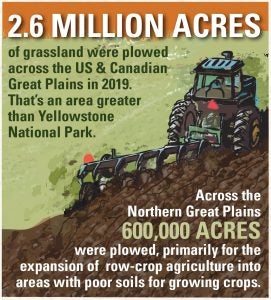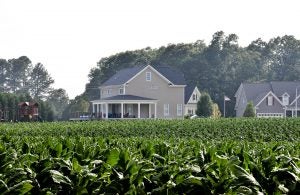My mentor at work often tells me that “everything runs downhill.” She’s usually referencing old files with stale claims, non-billable work, and unpleasant assignments. And she’s usually joking. The buck is supposed to stop at the top, right?
But I increasingly feel like this mantra is actually true when it comes to agriculture. Farmers are always at fault. And if we could only get them to stop thinking solely about profits, maybe we could solve the world’s biggest problems.
The World Wildlife Fund’s 2021 Plowprint Report demonstrates the point. According to their data, an additional 2.6 million acres of intact grasslands were converted for cultivation in 2019. WWF says farmers plowed that ground to grow wheat, corn, and soybeans. WWF’s news release disparages “destructive” agricultural practices. It suggests creating legislation that would protect grasslands the same way we currently protect wetlands, reduce the availability of crop insurance for grasslands, and put pressure on corporations to protect grasslands through their supply chains.

But land use is a complicated topic, and it’s hard to make such sweeping generalizations. Are farmers cultivating wide swaths of grasslands just because they’re greedy and have no regard for the environment? Not likely. So while I’m not saying WWF’s numbers are wrong, I’m saying there may be more to the story.
According to American Farmland Trust, the U.S. loses 2,000 acres of farmland to development every single day. If you need some perspective, my family farms just over 2,000 acres. That’s how much we’re losing. Every. Single. Day.
So to really analyze WWF’s claims — and consider whether their proposed solutions will work — we need to get a better sense of what’s actually happening. Was this land previously cultivated and then taken out of rotation for conservation purposes? Maybe the farmers plowing up new grasslands had to because they lost other land to urban development. Imagine if those farmers had no other choice; cultivate grasslands or go bankrupt. The point is, we don’t really know. So making broad, generalized statements doesn’t actually help.

Yet our society seems to always blame farmers and tap agriculture to change. Take climate change. We’re told climate change is an existential threat. We know greenhouse-gas emissions come mostly — 54 percent — from transportation and electricity. So why is all the focus on changing agriculture, which produces only 10 percent? According to the popular narrative, we’re supposed to farm differently, give up meat and dairy, and focus on sequestering carbon.
The answer to me seems really obvious: because it’s easy. Unlike most modern-day industries, farming seems super simple. You just take a seed, bury it in dirt, add some water, and before long you have a crop. Contrast that with the intricacies of building a smartphone app, designing a nuclear power plant, or taking people into outer space. That stuff is hard in comparison.
It’s also an easy way for ordinary folks to participate. If we’re told that regenerative agriculture is going to save the world, we can simply choose food with that label. All of sudden we’re transformed from a drag on the environment to an environmental justice warrior! So easy conclusions, devastating statistics, and passive action are the way to go.
By the way, if you’re wondering, WWF also weighs in on other agriculture issues that have a strange relationship to this latest report. It doesn’t support or endorse the use of GMO, even though the adoption of GMOs reduces carbon emissions. And it encourages people to switch to a vegan diet to reduce each person’s carbon footprint (even though that swap would make minimal difference). Again, it’s funny how WWF says it cares about the environment and climate change, but it’s position on modern agriculture seems to suggest the complete opposite.
Farmers are willing and able to meet the challenges of this age. In fact, the entire industry has become incredibly more efficient, effective, and environmentally friendly over the last half century or so. But farmers shouldn’t have to bear the burden of saving the world, while also being blamed for its problems.
Amanda Zaluckyj blogs under the name The Farmer’s Daughter USA. Her goal is to promote farmers and tackle the misinformation swirling around the U.S. food industry.



